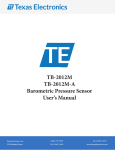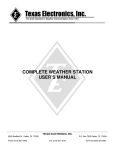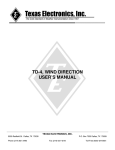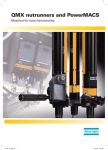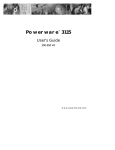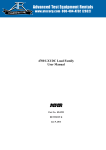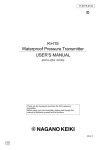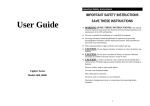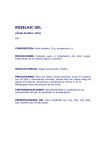Download tb-2012m barometric pressure sensor user`s manual
Transcript
TB-2012M BAROMETRIC PRESSURE SENSOR USER’S MANUAL TEXAS ELECTRONICS, INC. 5529 Redfield St. Dallas, TX 75235 Phone (214) 631-2490 P.O. Box 7225 Dallas, TX 75209 Fax (214) 631-4218 Toll Free (800) 424-5651 MICRO SWITCH USA U1 Texas Electronics, Inc. P1 P2 5529 Redfield St. Dallas, Tx 75235 C3 D3 TB1 Remove cover of TB-2012M and adjust D2 for local pressure. R21 D4 Refer to Pressure vs Voltage/Current D1 Table under the Barometer section of +12V COM. SIG. COM. the service manual. C99 C1 Model TB-2012M Barometer R3 R4 R2 R1 R18 R19 R20 C98 R13 R14 R16 R22 REF C5 C7 R17 C6 ELECTRIC BAROMETER MODEL NO. TB-2012M S/N 102795 C4 U2 R11 R12 R8 R9 SPAN C2 U3 R15 NULL MODEL TB-2012M BAROMETRIC PRESSURE SENSOR (Shown with cover removed) DESCRIPTION The Texas Electronics, Inc. TB-2012M Barometric Pressure Sensor uses an active solid-state device to sense barometric pressure. Self-contained electronics provide a regulated voltage to the solid-state sensor and amplification for the signal output. The unit's range of 26" to 32" or 878 mb to 1080 mb of mercury allows it to be used at elevations up to 1800 feet or 548.64 meters above sea level. The unit is temperature compensated from -18° to +50°C. if elevations above 1800 feet or 548.64 meters are required, contact the factory for higher elevation calibration. SPECIFICATIONS Calibration Range: Supply Voltage: Current Draw: Accuracy: Operating Temperature Range: Calibrated Temperature Range: Output: Optional Output: Weight: Dimensions: 26" to 32" or 878 mb to 1080 mb 12 to 15 VDC <15 mA +/- 1.3mb -40° to +50°C -18° to +50°C 0-1 VDC 4-20 mA 2 lb. or 8.9 N or .907 kg. w/ 60 ft. or 18.3 meters cable 6" or 15.24 cm H x 5" or 12.7 cm W x 3" or 7.62 cm D (Single enclosure: double enclosure also available) Warranty: 3 year FEATURES & BENEFITS • • • • • • • Interfaces to virtually all data acquisition systems Can be used up to 1800 ft. elevation without factory modification Over 1800 ft. elevation applications available Easy installation and maintenance Over 5 years in production Weatherproof Nema Enclosure for superior outdoor protection Wide range of 26" to 32" Hg. or 878 to 1080 mb INSTALLATION & MAINTENANCE Select a site where the instrument will not be subject to rapid fluctuations of temperature or to jarring and continuous vibration. Avoid exposing the instrument to direct sunlight or radiant heaters and to direct drafts such as open windows and doors. A mounting bracket with hardware is attached to the Nema enclosure of the sensor. ORDERING INFORMATION Model # Description TB-2012M TB-2012MA Barometric Pressure Sensor Barometric Pressure Sensor, 4-20 mA Optional Parts / Accessories Cable High Elevation: Additional Cable Applications of higher than 1800 ft. or 548.64 meters above sea-level require factory modification. PROPER EXPOSURE OF METEOROLOGICAL INSTRUMENTS Generally recognized guidelines follow which depict "ideal" sensor mounting locations. These guidelines or "rules of thumb" are only suggestive in nature in an attempt to aid the user to selecting optimum representative sampling locations for a particular sensor. Reference was made to US Weather Bureau Installation criteria in preparing this data (See Reference 1). WIND EQUIPMENT: So far as available sites permit, wind sensors should be placed above the ground on a freely-exposed tower (20 feet or higher) and over terrain that is relatively level and free from obstructions to wind flow. When a compromise must be made, sensing units should be exposed at least 12 feet above any obstruction within 100 feet and at least as high as any obstruction within 100 to 200 feet of the wind equipment. Support towers or masts should not be of such bulk or shape as to create an appreciable obstruction to wind flow. Avoid sites where local obstructions may create up-or-down drafts, eddy currents or jet-flow effects. When sensors are roof-mounted, they should be installed at least 10 feet (or greater) from the roof surface depending upon the particular installation site. Turbulence and other local effects can be reduced somewhat by mounting sensors on the upwind and of the building (that end of the building exposed to the most common local prevailing winds). Horizontal-mount booms which extend from existing towers should be fabricated so that sensors will extend a distance of 5 to 10 feet from the tower assembly (dependent on tower thickness). Wind direction sensors are oriented upon installation in reference to either true north or magnetic north. True north is obtained by applying a local magnetic variation correction factor to a magnetic north compass indication (magnetic variation for a particular locality is obtainable from the nearest Weather Bureau Branch Office). Indicator readings for a true north sensor orientation will then be in terms of true geographic compass points. All U.S. Weather Bureau surface wind data used for observational network reporting purposes and general public use is given in reference to this true north format. Indicator readings for a magnetic north sensor orientation will be in terms of actual readings as would be obtained from directly viewing a magnetic compass instrument. Wind direction data at Federal Aviation Agency and other aircraft reporting facilities (for direct control tower-to-pilot utilization) is always made in reference to this magnetic north format. REMOTE TEMPERATURE/HUMIDITY SENSORS AND INSTRUMENT SHELTERS: Whenever possible, instrument shelters* as well as remote temperature and/or humidity sensors should be installed at a height of 4 feet (or greater) over earth or sod at least 100 feet from any concrete or other hardsurfaced area and not closer to any other object than four times the height of the object above the instrument shelter or remote sensors. Avoid roof installations if possible. If it is necessary to roof-mount shelters and sensors, they should not be closer than 30 feet to any large, vertical reflecting surface (walls, etc.), exhaust fans, or cooling towers. Electronic remote sensors when roof-mounted should be at least 9 feet (or greater) above the roof surface. To minimize radiation effects from the roof, they can also be mounted on a horizontal boom so that they will extend from the side of a building roof or existing tower. Horizontal booms should extend approximately 5 to 10 feet from the side of the building roof or tower assembly. PRECIPITATION GAUGES: Rain gauges should be installed on a level plot of ground, at a distance from any object of at least two and preferably four times the height of the object above the top of the gauge. All types of gauges must be exposed with the rim of the receiver in a horizontal plane and at a level well above the average level of snow surfaces. * Standard U.S. Weather Bureau cotton-region shelter (Spec. No. 450.0615, Rev. 8/67) Roof-mounting of rain gauges should be avoided when possible. Air currents at heights other than at ground level have been observed to cause an apparent decrease in rainfall catch commensurate with the increase in mounting height above ground level. Objects which individually or in small groups constitute a "windbreak" reduce prevailing wind speed in the vicinity of the gauge. This reduction of wind speed will, as a consequence, also reduce possible eddy currents and turbulence around the gauge. The presence of such objects is usually beneficial in providing a more accurate rainfall catch. Ideally, the "windbreak" objects (fences, bushes, etc.) should be generally uniform in height and distance from the gauge. Height above the gauge should not exceed about twice their distance from the gauge. ANEROID BAROMETERS - SELF-CONTAINED MECHANICAL INSTRUMENTS AND ELECTRONIC REMOTE BAROMETRIC PRESSURE SENSORS: Select a site where the instrument will not be subject to rapid fluctuations of temperature or to jarring and continuous vibration. Avoid exposing the instrument to direct sunlight or radiant heaters and to direct drafts such as open windows and doors. Reference 1: U.S. Department of Commerce - National Weather Service Bulletin LS 5927 Revised, 0-4.12, January, 1963. SOLAR RADIATION SENSORS: The Solar Radiation Sensor is normally mounted on a level surface totally remote from trees, poles, or power lines that might cast a shadow on the sensor at any time of the day. However, there may be occasions, because of extreme latitudes, when it is desired to mount the sensor at some angle other than level. The sensors may also be mounted on a sun tracking mechanism or behind a shadow band if diffuse sky radiation is to be measured. TB-2012M ALTITUDE SETTING INSTRUCTIONS To set barometer to your elevation, follow the instructions listed below: Output: Range: 0-1V 26 to 32” .1666V/Inch .001666V/.01 Inch Obtain local barometric pressure from NOAA, NWS, airport, radio/TV station, or from any facility that would have the most accurate information closest to your installation. If you are using the Texas Electronics, Inc. digital or analog indicators, remove the four cover screws from the TB-2012M and adjust the null pot (R15) until your indicators agree with the reference obtained. You may want to do this more than once, especially if the weather is unsettled at the time. If you are connected to a Solus® Data logger you can set to your elevation by inserting either a plus or minus voltage in the [calibrate] Offset : xxxx box. With Solus running follow these steps: from menu bar, click on setup, sensor, edit, select TB-2012M then insert value desired then save, .10 increases reading by .10” -.10 decreases reading by .10” By using the chart below and the following conversion, it is very easy to set up. Example: If the pressure reading that you obtained is 29.13”: From the chart below: Choose 29, which is .500 V. Then multiply, 13 x .00166 V. = .0216 V. .5 V. + .0216 V. = .52160 V. should be the proper output. Set null pot (R15) until that voltage output is obtained. 26” 27” 28” 29” 30” 31” 32” = = = = = = = .00 V. .166V. .333V. .500V. .666V. .833V. 1.000V. NOTICE! IF THE FINAL OUTPUT FROM THE OVERALL SYSTEM IS OTHER THAN 0-1 VOLT, THERE WILL BE A PA-03-1 AMPLIFIER INSTALLED IN THE ELECTRONICS PACKAGE SUCH AS THE BPC-250 OR BPC-500. THE OUTPUT FROM THE TB-2012M IS FED DIRECTLY INTO THE PA03-1 AND AMPLIFIED TO THE USERS NEEDS. BE SURE TO TAKE THIS INTO CONSIDERATION WHEN SETTING UP THE SYSTEM AT IT’S PERMANENT ELEVATION. Replace cover and secure evenly. System should not need further calibration or setup. Altitude ( feet) R14 25 00 - 9500 44 .2k 95 00 - 13500 61 .9k 13 500 - 1550 0 75 .0k 17 500 - 2050 0 1 1 0 K ( R 1 5 = 5 0 K) Ma x imu m Altitude is 20500 Fe et Standard Output Is 0-1 Volt (166Mv./In.) Altitud e: 0 -250 0 Fe et Ra nge : 26 " to 32" Hg Fo r Altitu d e ab ove 25 0 0 feet Se e Ch art Abo ve For 0-2.5 Volt Output R14=50K R15=5K R16=95.5K R17=50K P OT P OT For 0-3 Volt Output R14=50K R15=20K R16=120K R17=10K P OT P OT For 0-5 Volt Output R14=64.9K R15=20K R16=191K R17=50K P OT P OT Warranty Texas Electronics, Inc. (hereafter TEI) warrants the equipment manufactured by it to be free from defects in material and workmanship. Upon return, transportation charges prepaid to TEI, within three (3) years of original shipment of sensors and one (1) year of original shipment of electronics, recorders and indicators, TEI will repair or replace, at its option, any equipment which it determines to contain defective material or workmanship, and will return said equipment to purchaser, F.O.B., TEI. Texas Electronics shall not be obligated however to repair or replace equipment which has been repaired by others, abused, improperly installed, altered or otherwise misused or damaged in any way. TEI will not be responsible for any dismantling, re-assembly, or reinstallation charges. This warranty is in lieu of all other warranties, expressed or implied. TEI shall not be liable for any special, indirect, incidental or consequential damages claimed in connection with any rescission of this agreement by purchaser. For a list of specific items covered by the extended warranty, see the Three-Year Warranty Equipment List. Three-Year Warranty Equipment List Effective February 1, 1992 all of Texas Electronics, Inc. sensors will carry a Three-Year warranty instead of the previous One-Year. The remainder of terms and conditions of the warranty remains unchanged. A specific list of items follows. Sensors Covered by Three-Year Warranty Parameter Wind Direction Wind Speed Barometric Pressure Relative Humidity Rainfall Temperature Solar Radiation Model No. TD-105 (Synchro) TD-104D (Potentiometer) TD-110-L2 (Photo-Chopper) TD-106 (Potentiometer) TV-110-L2 (Photo-Chopper) TV-110-L3 (Photo-Chopper) TV-114 (A.C. Generator) TB-2012 TH-2013 TH-2013V TR-525 TR-6118 TT-101 (Outdoor) TT-103R (Surface Mount) TT-103R-W (Water Probe) TT-309I (Indoor) TS-100 Systems Covered by Three-Year Warranty Model No. WSC-5-S WSC-5-ST WSC-5-D WSC-5-DT WDC-2 Description Wind Speed Controller Single Set Point Wind Speed Controller Single Set Point with Time Delay Wind Speed Controller Dual Set Point Wind Speed Controller Dual Set Point with Time Delay Wind Direction Controller









